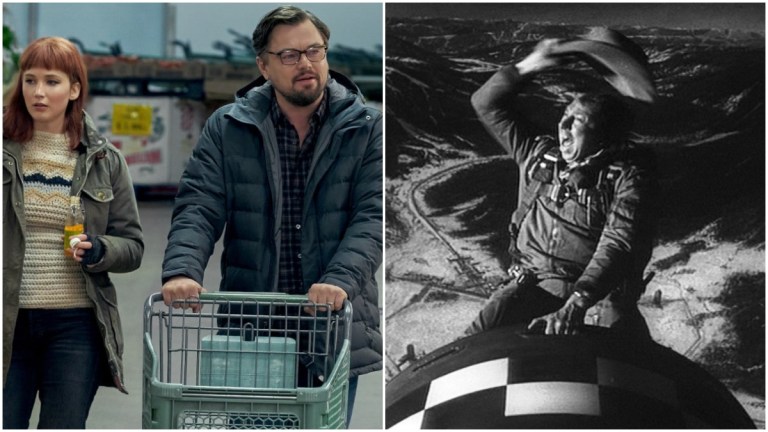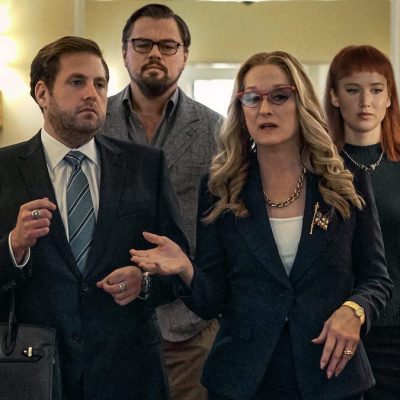Why Don’t Look Up Fails to Match Its Dr. Strangelove Idol
Don’t Look Up badly wants to be Dr. Strangelove for the climate crisis, but it never learns to stop worrying and love the bomb.

This article contains Don’t Look Up spoilers.
Is this really happening? That is the anxious, painfully relatable plea Leonardo DiCaprio’s Dr. Randall Mindy cries repeatedly during the pre-title sequence of Don’t Look Up. Over the extended prologue of the new Adam McKay and Netflix phenomenon, Mindy and his best student, PhD candidate Kate Dibiasky (Jennifer Lawrence), have discovered that a comet is a) going to collide with earth in six months; b) that it will trigger an extinction level event; and c) it’s forced them to inform the President of the United States that all life on Earth is about to end.
With McKay’s camera practically touching DiCaprio and Lawrence’s eyeballs, we are made to feel their each and every agonized breath as they grapple with the gravity of the situation. In this way, the tight handheld photography of these scenes is not that different from how McKay filmed the third act of his first (and still best) “dramedy,” the Oscar winning The Big Short. And, indeed, after several decades now of dispiriting international incidents and failures—from the Iraq War, to the Great Recession, to COVID—these opening moments where we’re asked to consider the reality of a planet-killing comet feel depressingly authentic.
Which is perhaps why only after Dibiasky is shaken enough to run over to a White House trash bin and throw up that McKay drops his retro opening title cards. With candy-colored hues and a gigantic all-CAPS font, the names of McKay, DiCaprio, Lawrence, and a cornucopia of other celebrities flash by alongside the “Don’t Look Up” title card, as if they’re all appearing in a Las Vegas revue together.
The opening title sequence is a throwback—a hammy wink and a nudge that this is a comedy, folks! And a star-studded one like those from the ‘60s. Think It’s a Mad Mad Mad Mad World (1963) or the original Casino Royale (1967). And yet, while those are what Don’t Look Up’s title cards are emulating, it’s obviously another 1960s picture altogether that it wants to be: Stanley Kubrick’s Dr. Strangelove or: How I learned to Stop Worrying and Love the Bomb.
That 1964 masterpiece was another pitch black comedy about the end of the world, although one pitched more directly toward the terrors that got to Kubrick and Peter George, the latter of whom wrote the novel Red Alert on which Dr. Strangelove is loosely based. That book, like the ultimate film, imagines the horrors which could occur if a rogue general or patriot among one of the Cold War’s two great superpowers, the United States and the Soviet Union, decided to push the proverbial button and trigger a nuclear holocaust.
George also contributed to early drafts of the script until Kubrick realized there was something inherently funny and bleakly amusing about “mutually assured destruction” and began retooling the film into something of a farce. Hence how a specific (and entirely rational) fear about extinction in the mid-20th century could also give way to that era’s best comedy—a literal black and white theater of the absurd where credible actors like George C. Scott and Sterling Hayden traded barbs with one of the great comic stars of all-time, Peter Sellers. And since Sellers is playing multiple roles, he has the freedom to vary between the understated and droll, such as his British air force officer, Capt. Mandrake, and the outright cartoonish as gleaned by his Nazi-saluting, nuclear German scientist, Dr. Strangelove.
Both movies are about man made stupidity risking the fate of the world, and both movies sell that fact by ending said world on-screen. In Dr. Strangelove, it’s with a holler of delight as Slim Pickens’ Air Force major rides a hydrogen bomb all the way down to Mother Russia; in Don’t Look Up, it’s with Mindy and Dibiasky’s comet smashing headlong into Earth, causing all life to be obliterated.
Yet the contrast between these two comedies is striking because while Dr. Strangelove remains an endearing and surprisingly timeless portrait of institutionalized insanity, Don’t Look Up has been met with a mixed reception which underscores the ultimately off-putting nature of McKay’s own apocalyptic vision. And the distinction that separates them can be traced right back to that opening prologue of the 2021 movie where Lawrence’s character vomits into a bucket.
Like Dr. Strangelove, Don’t Look Up is a movie made by a filmmaker distressed by the policies and processes used by world leaders—be they in government, media, Silicon Valley, or elsewhere—in the face of an existential threat. In the case of the modern movie that’s climate change, a menace we’ve known about for decades. But despite the near universal agreement among scientists about the threat it poses to humanity and the many other species on the planet, and the increasingly dire annual evidence that it’s real, many political leaders and corporate interests deny its very existence. Particularly in the U.S.
However, unlike Dr. Strangelove, rather than make a movie darkly amused by the lunacy of the situation, Don’t Look Up is strident, furious, and in a state of perpetual panic. And it’s determined to get through to the viewer, even if it has to scream its point over a mammoth two and a half hour running time.
Thus the characters of Dr. Mindy and PhD candidate Dibiasky, as well as to a lesser degree Rob Morgan’s Dr. Teddy Oglethorpe. We’re introduced to all three in Don’t Look Up well before we meet Meryl Streep’s Trumpian buffoon, President Orlean, or her parasitic finance bro son, Jason Orlean (Jonah Hill), never mind Cate Blanchett and her cheshire grin as morning news TV personality, Brie Evantee, or Mark Rylance as Peter Isherwell, an unholy blending of Steve Jobs, Elon Musk, Mark Zuckerberg, and Jim Jones.
Mindy, Dibiasky, and Oglethorpe are the audiences’ eyes and ears, as well as their proxies in which a moral authority voice from on high—or at least from the scientific community for our secular world—is unburdened. They’re here to scold and castigate the political and media establishment for 150 minutes. They’re also intended to reprimand an audience too who might be more familiar with Ariana Grande than the current White House chief of staff.
It’s so fiery, so passionate, and so self-satisfied, it doesn’t really seem aware that the humor doesn’t really work when its main characters aren’t committed to the bit. By having one of its audience avatars exclaim to the camera, “Maybe you should stay up all night every night crying, because we’re all 100 percent for sure going to fucking die!” the film is literally screaming its message. Of course this is by design, as McKay’s script also couches this scene in a moment where Dibiasky is “losing” the audience by not playing the phony game of having a media strategy. Nevertheless, the scene also subconsciously reminds the audience that they, like these protagonists, don’t quite live in the otherwise satirically heightened world McKay creates when he has a three-star general con a NASA scientist out of $20. We’re better than them, so we can dismiss this purely as schadenfreude as we wait for the dumb-dumbs to get wiped out.
By contrast, there is no tonal confusion or sanctimonious proselytizing in Kubrick’s Dr. Strangelove, which is why its message and storytelling are more effective. There’s no audience surrogate, no voice of wisdom, and no “adults in the room” that just needed to be ceded enough floor space to lecture the dummies whom its target audience naturally disagrees with. Rather we’re all doomed because we’re all complicit in building this foolish world, according to Kubrick’s detached sensibility and merciless script.
The film’s own less aggressive opening title sequence—and certainly more restrained when compared to other ‘60s comedies that Don’t Look Up emulates—is centered around real stock footage of two U.S. Air Force aircraft refueling while in midair. When presented over slow, melodic shots as mechanical, phallic-shaped pieces extend from one aircraft to another, and fuselages are filled, and an airy orchestral cover of “Try a Little Tenderness” plays, it all looks ridiculous… yet tangibly real. This is actual footage recorded by the U.S. military re-contextualized by a cinematic dirty mind which promises to look at these real world systems and institutions from a mischievously skewed vantage.
And that it does without any lifeline or concessions to reality. There are no characters for audiences to latch onto while feeling moral superiority over the rest. The first player we meet, Sellers’ RAF Capt. Lionel Mandrake, is certainly the most grounded figure, and one who is trying to do the right thing and prevent World War III. But from his mannered and fastidious line readings to the way that Kubrick films the character, particularly while in the presence of the genocidal madman Brig. Gen. Jack D. Ripper (Hayden), leaves Mandrake always appearing meek, ineffectual, and doomed. In the sequence where Ripper reveals to Mandrake that he’s manufactured a scenario and sent nuclear armed bombers toward Russia, the rational British officer is observed entirely from Ripper’s perspective, with the camera behind Sterling Hayden’s shoulder and yet being positioned at just enough of an angle to catch the sneering profile of his contemptuous cigar.
War hawks like Ripper hold the cards in this Cold War idiocy, and the levelheads are really so many schmucks who don’t even get to be in the real room where it happens. Indeed, Mandrake ultimately disappears from the film, never even getting to deliver on-screen his message of urgency for the American president. Meanwhile that same figure, played with an initially understated stuffiness also by Sellers, is entombed in one of the finest sets ever designed by Ken Adam: the war room.
All ominous screens and orderly, circular overhead lights and tables, the war room is a triumph for a production designer who until Dr. Strangelove was best known for his work on the James Bond movies. It is at once imposing with its cavernous shadows and also pretentiously self-serious. A fact the movie slowly eases the audience into realizing as Sellers’ effete president haplessly battles with his most dimwitted military leader, Gen. Buck Turgidson (George C. Scott).
Turgidson is a character designed to personify the madness of the happy Cold War warrior with his iconic line of “10 to 20 million dead, tops!” He also is the one who gets to whine repeatedly to his president about the Russian ambassador being invited into their super cool, and super secret war room. “But he’ll see everything! He’ll see the big board!” Turgidson cries this as he attempts to stuff the papers in front of him under his arm. Suddenly, the realpolitik strategies and counterstrategies that brought the world to a real nuclear brink only two years before Dr. Strangelove was released looks like so many boys playing with their toys in a treehouse.
This is more or less the entire tone of the picture. There are no saints or martyrs, heroes or villains. They’re all buffoons, and the titular Dr. Strangelove is just the loudest one in the room as he pitches his vision for a humanity hidden in mineshafts and divided among young women and old men by a ratio of 10:1. The movie builds like a crescendo to its most insane punchline, right down to the previously disabled Strangelove rising from his chair to scream, “Mein Fuhrer, I can walk!”
Conversely, Don’t Look Up never finds that tonal balance and ultimately becomes a long—exhausting, even—screed intended to preach to its own choir about their superiority over nitwits likes its President Orlean and the New York Times journalists who stop writing about climate change the comet because of too few clicks.
Rather than grow more absurd, Don’t Look Up ends like a somewhat different movie altogether as Mindy, Dibiasky, and Ogelthrope, plus Mindy’s family and Dibiasky’s new fiancé, gather for a sweet home cooked meal before the end of the world. In this way, the ending plays closer to existential dramas like Melancholia than farce or satire. And save for a post-credits sequence that tries too hard to outdo Dr. Strangelove’s “mineshaft” theory, the film ends still weeping in sorrow for the world.
Dr. Strangelove never forgets what the joke is. It ends in much the same way it begins too. If the beginning was an intimate coupling between aircraft, then the finale is a montage of orgasmic nuclear explosions scored to one of the great lovers’ ballads from World War II: “We’ll Meet Again.” Dr. Strangelove really is a movie that stopped worrying and made love to the hydrogen bomb. That makes for a much more potent and chilling satire than the one that’s screaming in your ear with all the sound and fury of Howard Beale—another character from a dark satire which never attempted to make audiences feel better about looking into a mirror.


